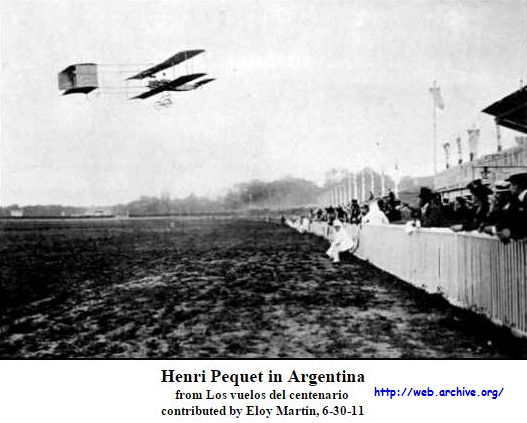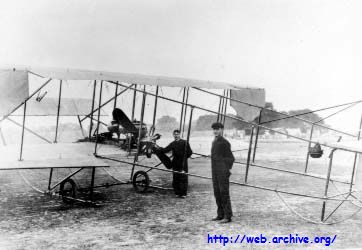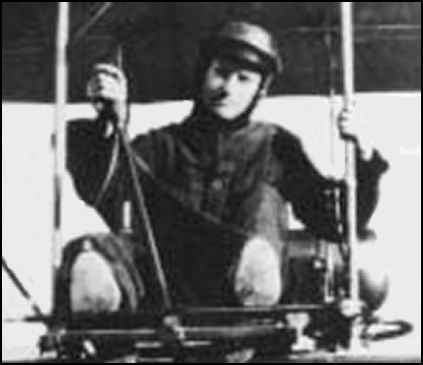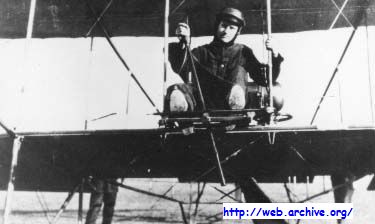Sea
also story of the first airmail
web.archives
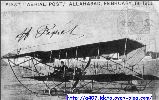
|
18
FEVRIER 1911 - Les débuts de la poste
aérienne
HENRI PEQUET( 1888-1974) ,
le premier "facteur du ciel"
|
|
|
Né le 1 février
1888 à Bracquemont, France Décédé le 13 Mars
1974 à Vichy, France
Il a commencé
sa carrière dans l'aviation comme aéronaute.
Il a rejoint la Société Voisin en tant que
employé en 1908, puis a fait son premier vol
à Hambourg en 1909.Il a obtenu sa licence
(No 88) 10 Juin 1910.
Le 18 Fev
1911, il réalise le premier postale sur
avion Sommer entre Allahabad et Naïni
en Inde.
^^ Au cours de
la première guerre mondiale, il fut employé
à Morane-Saulnier, et fut envoyé en Russie
pour lâcher les pilotes après l'achat
d'avions MS. Il revint en France en 1918
pour devenir chef pilote chez
Morane-Saulnier. Avant la seconde guerre
mondiale, il était pilote instructeur et
directeur de l'aérodrome de Vichy-Rhue. Il a
travaillé dans la résistance pendant la
guerre, a été capturé et déporté en avril
1943. Après la guerre, il est directeur de
l'aéroport de Vichy.
(web-archives1
web-archives2)
|

|
|
SOUVENIRS EN FORME D'INTERVIEW
Extrait des
"Ailes Brisées"
|
|
|
- Henri Pequet quand
êtes-vous arrivé à I'aviation? (Note 0)
En 1908, j'ai commencé comme mécanicien de
Gabriel Voisin. et c'est en cette qualité que
j'accompagnai Sanchez Besa au meeting de
Berlin (José
Luis Sanchez-Besa (1879-1954,
Chili Note
1). L'année suivante. .
- Et comme pilote?
Le 30 octobre 1909, j'ai pris un avion et je
me suis lâché - Quelques jours plus tard,
j'avais le feu à bord. Je crois que je suis le
premier auquel c'est arrivé. En 1910 je
participai au meeting de Buenos Aires, puis je
fus instructeur à Reims.
- Et votre brevet ? .
Je l'ai eu en 1910, après mes élèves que
j'avais tenu à faire passer avant moi. J'ai le
No 88-
-Sur quel avion?
Sur Voisin.
- Et comment
êtes-vous parti pour les Indes?
J'ai signé un contrat avec Humber de Coventry,
pour aller faire des démonstrations au meeting
et à l'exposition que l'on organisait à
Allahabad. Je suis parti avec un autre,
pilote, un Anglais, Davies
-Dans quelles
conditions s'est effectuée la première
poste aérienne? L'appareil d'abord?
C'était un Sommer, avec un moteur rotatif
Gnôme de 50 CV. Biplan, biplace.
-Comme instruments de
bord?
Il ne faut pas croire que nous avions à cette
époque des tableaux de bord ! Devant nous.
C'était le vide. J'avais une montre au poignet
droit. et un altimètre sur le genou gauche
-Pas de compte-tours?
Non. Au départ. on réglait à environ 1200
tours au moyen de la "cloche à huile". que
l'on entendait battre et que l'on surveillait
avec sa montre.
-Le terrain
maintenant?
-C'était le terrain de polo
-La mission?
Rallier la forteresse de Nani, distante de
Allahabad de quelque trente kilomètres et
transporter un sac de 15 kilos de courrier.
6000 lettres et cartes. dont quelques-unes
pour le roi d'Angleterre, le roi d'Italie, le
roi des Belges, la reine de Hollande et
beaucoup de très hautes personnalités.
- Il y eut un cachet
spécial? .
Bien sûr. Car les organisateurs accordaient
beaucoup d importance à l'affaire. Le cachet
était composé de ces mots : "First aerial
post".
- Et vous en avez
encore un?
Naturellement. Je me suis écrit ce jour là !
Je lis : -Or. a reçu à Londres. la fin de la
semaine là !
-Quel jour exactement?
Le 18 février 1911
- Il faisait beau?
Bien sûr. Autrement on n'aurait pas volé
-Vitesse?
60 à l'heure en vol 50 pour l'atterrissage.
- Durée du vol?
27 minutes
- Le relief?
Plat J'ai suivi la route au milieu des forêts.
-Sur le vol lui-même,
des souvenirs? La foule au départ?
Surtout des buffles ! Dès le décollage il
fallait passer au-dessus du Gange. Et je
n'étais pas très rassuré.
-Il est large?
Oui. trois au quatre cents mètres… Mais ce
n'était tellement le bain que je craignais,
c'étaient les crocodiles.
- Et à l'arrivée la
foule?
Non. Un fonctionnaire des Postes à qui j'ai
remis mon sac.
-A quelle altitude le
trajet?
Quarante à cinquante mètres. Pas plus.
- Et la presse en a
parlé?
Oui. Voici un extrait d'un journal de
!'époque:
Je lis : "on a reçu de Londres, à la fin de la
semaine des lettres provenant des Indes et
portant un cachet nouveau dans l'histoire
postale, le premier cachet reconnu par les
autorités pour oblitérer des lettres
transportées par voie aérienne…Ce sont les
premières lettres distribuées officiellement
par aéroplane. Le supplément de transport
s'est élevé à six annas par lettre.
Note 0
Henri Péquet sera d'abord
aéronaute.Dès 1905 avec Baudry,il pratique
le ballon libre et quelques mois plus
tard,il fait équipe avec Louis Paulhan à
bord du dirigeable "Ville de Paris".
Il entre chez Voisin à Mourmelon en
1908 où il travaille en collaboration avec
Colliex,Gaubron et Buno-varilla. retour texte
Note 1
José Luis Sanchez-Besa (1879-1954)
Chili
En 1909, Sanchez-Besa engage comme
mécanicien Henri Péquet qui était depuis
1908 mécano chez Voisin à Mourmelon en
Champagne où il travaillait avec Colliex,
Gobron et Bunau-Varilla. Sanchez-Besa et
Henri Péquet sont au meeting de
Johannistal, près de Berlin et au meeting
de Hambourg. Par un très mauvais temps,
Sanchez-Besa hésite à prendre le départ.
Péquet offre à Sanchez-Besa de voler à sa
place, à condition que son contrat de
mécanicien soit transformé en contrat de
pilote. Sanchez-Besa accepte et Henri
Péquet effectue alors son premier vol
public. Sanchez Besa obtient le brevet de
pilote n° 155 en date du 9 août 1910. retour texte
|
|
|
![]() cou
cou